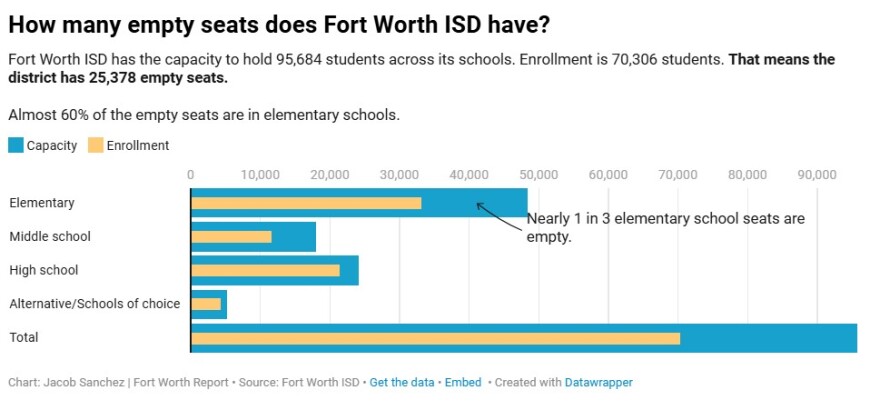A multitude of factors are pushing Fort Worth ISD to close schools.
None are related to the Texas Legislature’s proposal for a voucher program.
The biggest factor? Declining enrollment. Another contributor? Fort Worth ISD’s dollars and staff are spread too thin to adequately meet the educational needs of students, according to district officials.
Saving costs is not the district’s lodestar. Instead, leaders want to free up money and staff to boost academic achievement for all students.
Right now, Fort Worth ISD spends more on brick and mortar than on students, Deputy Superintendent Kellie Spencer said.
“Our dollars are not being spent most efficiently to support the instruction of children,” she told the Fort Worth Report.
Lower birth rates.
Empty nesters staying put.
Competition from charter schools.

All these things and more, have chewed away at Fort Worth ISD’s enrollment since the 2016-17 school year.

Enrollment decline eroded the number of children sitting in classrooms. Now, the district has too few students and too many empty classes.

Maintaining 140 campuses is not sustainable for a district working to turn itself around, Superintendent-designate Karen Molinar told residents during a trio of February community meetings.
Buildings must be kept safe, comfortable and dry for students, Spencer said.
“But when we are at a point where we are not doing that in an efficient way and, therefore, our dollars are not being spent efficiently to support instruction of children, we have to take a look at our facilities,” the deputy superintendent said.
The goal is to ensure dollars and staffing are distributed across schools to guarantee all students, regardless of where they live, have an opportunity to succeed, Spencer said.
On average, the district spends $11,000 per elementary student. Schools with enrollment of fewer than 300 students spend an average of $15,000. At the same time, other schools receive significantly less.
“Sometimes as much as $7,000 less per student. That just doesn’t seem like the best investment to give all kids equitable access to the best educational program that we can offer,” Spencer said.
What about vouchers?
“They’re not impacting our decisions right now,” Spencer said.
Fort Worth ISD officials acknowledged closing schools is a difficult conversation for the community. People love their schools.
Their schools, though, are more than buildings.
As schools close and merge, the district plans to use the people who built successful, student-centered campus cultures and merge them together in a single building.
“People love the people in the building,” Spencer said.
The teachers. The staff. The principal.
They make a school a school.
Jacob Sanchez is a senior education reporter for the Fort Worth Report. Contact him at jacob.sanchez@fortworthreport.org or @_jacob_sanchez. At the Fort Worth Report, news decisions are made independently of our board members and financial supporters. Read more about our editorial independence policy here.
This article first appeared on Fort Worth Report and is republished here under a Creative Commons license.









